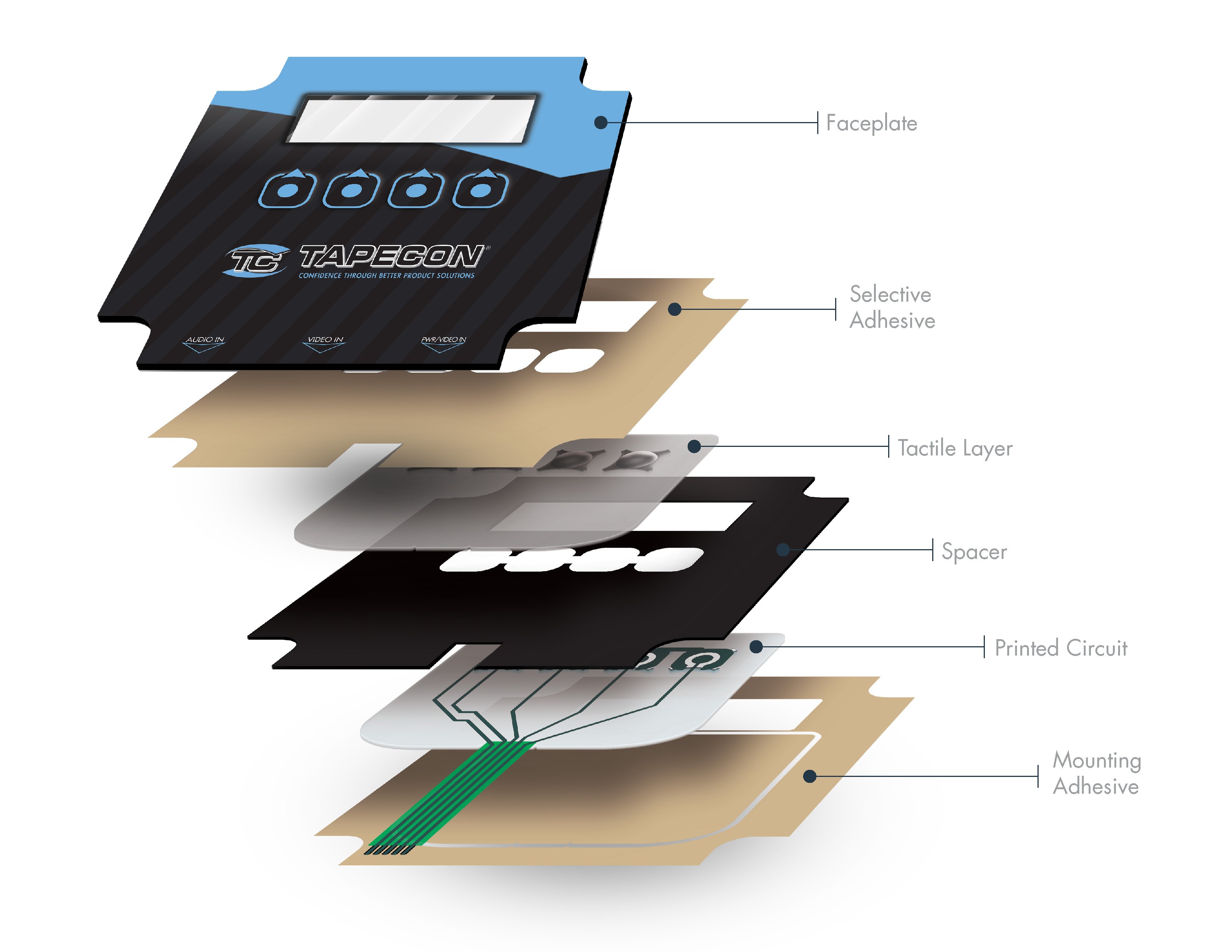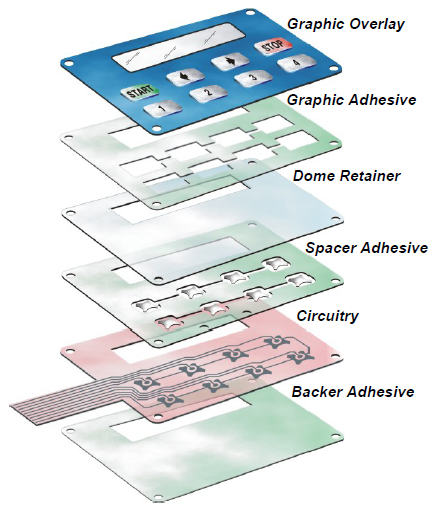Recognizing Membrane Changes: The Trick to Dependable and long lasting Controls
Membrane layer changes stand for a vital element of contemporary user interface design, blending capability with durability in numerous applications. These versatile components not just help with customer communication however are additionally crafted to stand up to the roughness of requiring settings, from medical devices to commercial equipment. Comprehending their building, operation, and the myriad advantages they offer is essential for designers and engineers alike. As we discover the details of membrane layer buttons, it comes to be clear that their duty in improving control systems is both profound and complex, questioning concerning exactly how best to utilize their abilities in future advancements.
What Are Membrane Buttons?
Membrane switches are an advanced option in the realm of individual interface technology, integrating functionality and layout flawlessly. These gadgets work as a user interface between individuals and electronic systems, incorporating numerous parts right into a compact style. Typically constructed from flexible, thin layers of products, membrane layer switches are developed to reply to touch, making it possible for customers to communicate with equipment and electronic gadgets efficiently.
The primary components of a membrane switch include a printed circuit layer, graphic overlay, and a spacer layer that protects against unintentional activation. The visuals overlay can be personalized to mirror brand name identity or individual preferences, boosting aesthetics while guaranteeing use. Membrane switches are typically used in different applications, consisting of medical gadgets, customer electronic devices, and commercial tools, owing to their resilience and resistance to environmental factors such as dampness and dust.
One of the essential advantages of membrane layer switches is their ability to withstand damage, making them excellent for high-traffic atmospheres. In addition, they are light-weight and need marginal area, enabling ingenious designs in item development. Generally, membrane changes stand for a useful and efficient selection for contemporary digital interfaces, marrying technology with user-centric layout concepts.

How Membrane Switches Work
The procedure of membrane switches depend upon an easy yet effective device that equates user input into digital signals. These switches contain multiple layers, normally consisting of a visuals overlay, a spacer layer, and a circuit layer. When an individual presses the switch, the leading layer warps, enabling a conductive aspect in the circuit layer to reach a corresponding conductive pad on the bottom of the graphic overlay. This contact closes the circuit and sends out an electronic signal to the gadget, indicating that the button has actually been activated.
The style of membrane switches can differ, yet they typically include domes or tactile elements to provide responses to the user, enhancing the general experience. The materials used in membrane buttons, such as polyester or polycarbonate, contribute to their toughness and resistance to environmental aspects, including dampness and dust. The published circuits are typically encapsulated, which shields them from wear and tear over time.

Advantages of Membrane Buttons
One of the key advantages of membrane layer buttons is their versatility in layout, enabling them to be personalized to meet details individual requirements and visual demands. This adaptability includes different view industries, where various shapes, sizes, and colors can be used to improve customer interaction and visual appeal.
Furthermore, membrane buttons are understood for their longevity. Built from durable products, they are resistant to dust, wetness, and physical wear, which substantially expands their life expectancy contrasted to typical mechanical switches. This resilience makes them particularly suitable for high-traffic atmospheres and applications calling for long life.

Furthermore, membrane switches offer a structured account, resulting in a thinner style that can be incorporated into numerous devices without including bulk. This function not just improves the aesthetic appeal however likewise adds to an extra ergonomic item design.

Applications of Membrane Layer Switches
Versatile and straightforward, membrane layer switches discover applications across a broad variety of markets, including medical gadgets, consumer electronics, and industrial tools. In the clinical field, these buttons are read here integral to tools such as diagnostic equipment, person monitoring systems, and mixture pumps, where dependability and ease of cleansing are important. Their capability to stand up to severe environments and preserve performance makes them optimal for such applications.
In consumer electronics, membrane buttons are used in products like microwaves, cleaning makers, and remotes - membrane switch. Their sleek layout enables intuitive interface, improving the general user experience while supplying resilience and resistance to tear and wear
Industrial devices likewise gains from membrane switches, especially in control panels for machinery and automation systems. These switches offer defense against dirt and dampness, ensuring constant efficiency in challenging settings. Their customizable features allow manufacturers to tailor them to certain functional requirements, boosting performance and capability.
Choosing the Right Membrane Layer Change
When picking a membrane layer button, it is essential to consider different aspects that influence performance and viability for certain applications. The primary considerations include ecological conditions, responsive feedback, longevity, and style requirements.
First, evaluate the operating atmosphere; switches exposed to dampness, chemicals, or extreme temperatures need particular materials to make certain durability and performance. Next, evaluate the demand for responsive comments. Depending upon customer interaction, some applications may benefit from a tactile action to validate activation, while others may choose a non-tactile layout for aesthetic factors.
Resilience is an additional essential aspect; membrane layer buttons must be developed to endure regular use, influences, and abrasion. Make sure the picked button can sustain the anticipated lifecycle, particularly in high-usage circumstances.
Final Thought
Finally, membrane switches serve as vital parts in the design of reliable and resilient control systems across different markets. Their small design, incorporated with durable construction and my response adjustable features, boosts customer interaction while ensuring long life popular settings. The convenience of membrane layer switches over permits tailored options that fulfill details operational requirements, strengthening their relevance in modern innovation. membrane switch. As industries remain to evolve, the significance of incorporating effective membrane layer button solutions can not be overstated.
Membrane changes stand for an important element of contemporary user interface style, mixing capability with durability in numerous applications.Membrane buttons are an advanced service in the realm of individual interface technology, combining capability and style seamlessly. Normally constructed from adaptable, thin layers of products, membrane layer buttons are designed to respond to touch, making it possible for users to connect with machinery and electronic gadgets effectively.
The layout of membrane switches can differ, but they usually incorporate domes or tactile elements to offer comments to the customer, boosting the general experience.In conclusion, membrane changes offer as important components in the design of reputable and long lasting control systems throughout numerous sectors.